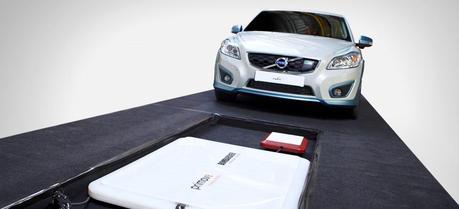 Volvo C30 Electric can be fully charged without a power cable in app. 2.5 hours. (Credit: Volvo Car Group)
Volvo C30 Electric can be fully charged without a power cable in app. 2.5 hours. (Credit: Volvo Car Group)Volvo Car Group has been a partner in a research project that has studied the possibilities of inductive charging for electric vehicles—and the results show that this technology for transferring energy via an electromagnetic field has a promising future. With inductive charging, energy is transferred wirelessly to the car’s battery via a charging plate buried in the road surface.
“Inductive charging has great potential. Cordless technology is a comfortable and effective way to conveniently transfer energy. The study also indicates that it is safe,” says Lennart Stegland, Vice President, Electric Propulsion System at Volvo Car Group, and adds “There is not yet any common standard for inductive charging. We will continue our research and evaluate the feasibility of the technology in our hybrid and electric car projects.”
Inductive charging uses an electromagnetic field instead of a cord to transfer energy between two objects. An induction coil creates an alternating electromagnetic field from a charging base station. A second induction coil in the portable device picks up power from the electromagnetic field and converts it back into an electrical energy that charges the battery. This technology is common in electrical home appliances such as electrical toothbrushes but is not yet commercially available to charge electric cars.
“With inductive charging, you simply position the car over a charging device and charging starts automatically. We believe that this is one of the factors that can increase the customer’s acceptance of electrified vehicles,” says Lennart Stegland.
“The tests demonstrated that our Volvo C30 Electric can be fully charged without a power cable in app. 2.5 hours. In parallel with this, we have also conducted research into slow and regular charging together with Inverto, which was also a partner in the project,” says Lennart Stegland.
Inductive charging can also be used in cars to charge consumer electronic devices. Earlier we reported that CE4A, a working group created by German car manufacturers (including BMW Group, Audi AG, Volkswagen AG, Porsche Automobil Holding SE and Daimler AG), recommended its members to use the Qi standard for inductive electrical power transfer in current and future vehicle models as an interface between consumer mobile devices (such as smartphones) and automotive engine control units.

